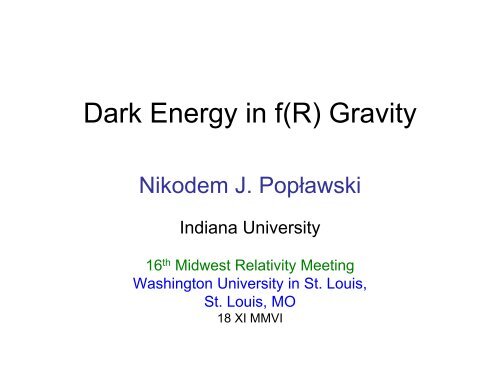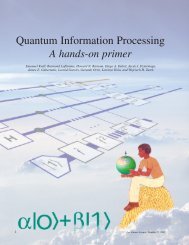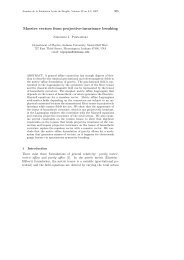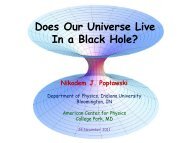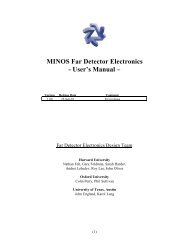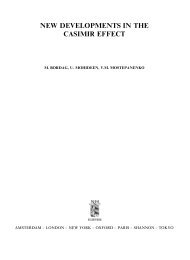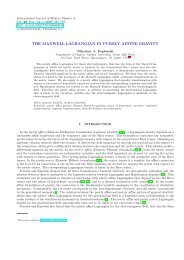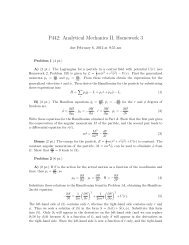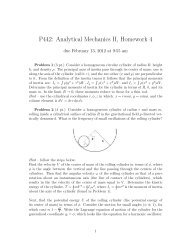Dark Energy in f(R) Gravity - Indiana University
Dark Energy in f(R) Gravity - Indiana University
Dark Energy in f(R) Gravity - Indiana University
Create successful ePaper yourself
Turn your PDF publications into a flip-book with our unique Google optimized e-Paper software.
<strong>Dark</strong> <strong>Energy</strong> <strong>in</strong> f(R) <strong>Gravity</strong><br />
Nikodem J. Popławski<br />
<strong>Indiana</strong> <strong>University</strong><br />
16 th Midwest Relativity Meet<strong>in</strong>g<br />
Wash<strong>in</strong>gton <strong>University</strong> <strong>in</strong> St. Louis,<br />
St. Louis, MO<br />
18 XI MMVI
Cosmic acceleration<br />
NASA / WMAP<br />
We are liv<strong>in</strong>g <strong>in</strong> an accelerat<strong>in</strong>g universe!<br />
References:<br />
A. G. Riess et al., Astron. J. 116, 1009 (1998)<br />
S. Perlmutter et al., Astrophys. J. 517, 565 (1999)<br />
Cosmological constant<br />
ΛCDM model<br />
1<br />
R <br />
2<br />
Rg<br />
T g<br />
Agrees with observations<br />
52<br />
2<br />
10<br />
m
<strong>Dark</strong> energy<br />
Hypothetical form of energy<br />
with strong negative pressure<br />
NATURE OF DARK ENERGY<br />
• homogeneous<br />
• not very dense<br />
• not known to <strong>in</strong>teract<br />
nongravitationally<br />
EXPLANATIONS<br />
• Cosmological constant<br />
• Qu<strong>in</strong>tessence – dynamical field<br />
• Alternative gravity theories<br />
(talks of G. Mathews and G. J. Olmo)
<strong>Dark</strong> energy<br />
Hypothetical form of energy<br />
with strong negative pressure<br />
NATURE OF DARK ENERGY<br />
• homogeneous<br />
• not very dense<br />
• not known to <strong>in</strong>teract<br />
nongravitationally<br />
EXPLANATIONS<br />
• Cosmological constant<br />
• Qu<strong>in</strong>tessence – dynamical field<br />
• Alternative gravity theories<br />
<strong>Dark</strong> Force =<br />
– <strong>Dark</strong> <strong>Energy</strong>
Variable cosmological constant<br />
Cosmological constant problem – why is it so small?<br />
No known natural way to derive it from particle physics<br />
Possible solution: dark energy decays<br />
Cosmological constant is not constant (Bronste<strong>in</strong>, 1933)<br />
Λ<br />
energy<br />
<strong>Dark</strong> energy <strong>in</strong>teract with matter<br />
Current <strong>in</strong>teraction rate very small<br />
matter<br />
Phenomenological models of decay<strong>in</strong>g Λ relate it to: t -2 , a -2 , H 2 , q, R etc.<br />
(Berman, 1991; Ozer and Taha, 1986; Chen and Wu, 1990; Lima and Carvalho, 1994)<br />
lack covariance and/or variational derivation
f(R) gravity<br />
• Lagrangian – function of curvature scalar R<br />
•R-1 or other negative powers of R → current acceleration<br />
• Positive powers of R → <strong>in</strong>flation<br />
M<strong>in</strong>imal coupl<strong>in</strong>g <strong>in</strong> Jordan (orig<strong>in</strong>al) frame (JF)
f(R) gravity<br />
• Lagrangian – function of curvature scalar R<br />
•R-1 or other negative powers of R → current acceleration<br />
• Positive powers of R → <strong>in</strong>flation<br />
M<strong>in</strong>imal coupl<strong>in</strong>g <strong>in</strong> Jordan (orig<strong>in</strong>al) frame (JF)<br />
• Fully covariant theory based on the pr<strong>in</strong>ciple of least action<br />
• f(R) usually polynomial <strong>in</strong> R<br />
• Variable gravitational coupl<strong>in</strong>g and cosmological term<br />
• Solar system and cosmological constra<strong>in</strong>ts<br />
polynomial coefficients very small<br />
G. J. Olmo, W. Komp, gr-qc/0403092
Variational pr<strong>in</strong>ciples I<br />
• f(R) gravity field equations:<br />
vary total action for both the field & matter<br />
• Two approaches: metric and metric-aff<strong>in</strong>e
Variational pr<strong>in</strong>ciples I<br />
• f(R) gravity field equations:<br />
vary total action for both the field & matter<br />
• Two approaches: metric and metric-aff<strong>in</strong>e<br />
METRIC (E<strong>in</strong>ste<strong>in</strong>–Hilbert) variational pr<strong>in</strong>ciple:<br />
• action varied with respect to the metric<br />
• aff<strong>in</strong>e connection given by Christoffel symbols (Levi-Civita connection)
Variational pr<strong>in</strong>ciples I<br />
• f(R) gravity field equations:<br />
vary total action for both the field & matter<br />
• Two approaches: metric and metric-aff<strong>in</strong>e<br />
METRIC (E<strong>in</strong>ste<strong>in</strong>–Hilbert) variational pr<strong>in</strong>ciple:<br />
• action varied with respect to the metric<br />
• aff<strong>in</strong>e connection given by Christoffel symbols (Levi-Civita connection)<br />
METRIC–AFFINE (Palat<strong>in</strong>i) variational pr<strong>in</strong>ciple:<br />
• action varied with respect to the metric and connection<br />
• metric and connection are <strong>in</strong>dependent<br />
• if f(R)=R metric and metric-aff<strong>in</strong>e give the same field equations:<br />
variation with respect to connection connection = Christoffel symbols<br />
E. Schröd<strong>in</strong>ger, Space-time structure, Cambridge (1950)
Variational Pr<strong>in</strong>ciples: Metric<br />
METRIC variational pr<strong>in</strong>ciple:<br />
• connection: Christoffel symbols of metric tensor metric compatibility<br />
• fourth-order differential field equations<br />
• mathematically equivalent to Brans–Dicke (BD) gravity with ω=0<br />
• 1/R gravity unstable – but <strong>in</strong>stabilities disappear with additional positive<br />
powers of R<br />
• potential <strong>in</strong>consistencies with cosmological evolution<br />
• need to transform to the E<strong>in</strong>ste<strong>in</strong> conformal frame to avoid violations of the<br />
dom<strong>in</strong>ant energy condition (DEC) EF is physical
Variational Pr<strong>in</strong>ciples: Metric–Aff<strong>in</strong>e<br />
METRIC–AFFINE variational pr<strong>in</strong>ciple:<br />
• no a priori relation between metric and connection<br />
• second-order differential equations of field<br />
• mathematically equivalent to BD gravity with ω=−3/2<br />
• field equations <strong>in</strong> vacuum reduce to GR with cosmological constant<br />
• no <strong>in</strong>stabilities<br />
• no <strong>in</strong>consistencies with cosmological evolution<br />
• both the Jordan and E<strong>in</strong>ste<strong>in</strong> frame obey DEC<br />
Work presented here uses metric–aff<strong>in</strong>e formulation
Jordan frame<br />
Assume action for matter is <strong>in</strong>dependent of connection (good for cosmology)<br />
Variation of connection <br />
connection = Christoffel symbols of<br />
~<br />
<br />
[ f '(<br />
R)<br />
g g<br />
<br />
~<br />
~<br />
]<br />
:<br />
<br />
0<br />
<br />
{} g
Jordan frame<br />
Assume action for matter is <strong>in</strong>dependent of connection (good for cosmology)<br />
Variation of connection <br />
connection = Christoffel symbols of<br />
Variation of metric <br />
~<br />
<br />
[ f '(<br />
R)<br />
g g<br />
Dynamical energy-momentum (EM) tensor generated by metric:<br />
Writ<strong>in</strong>g {} ~ ...<br />
g<br />
and<br />
R<br />
<br />
<br />
<br />
~<br />
~<br />
( ) R ( g)<br />
<br />
<br />
~<br />
<br />
]<br />
<br />
0<br />
<br />
{} g<br />
allows <strong>in</strong>terpretation of Θ as additional source and br<strong>in</strong>gs EOF <strong>in</strong>to GR form<br />
:
Helmholtz Lagrangian<br />
The action <strong>in</strong> the Jordan frame is dynamically equivalent to the<br />
Helmholtz action<br />
provided<br />
f " ( )<br />
<br />
0<br />
Scalar – tensor gravity (STG)<br />
GR limit and Solar System constra<strong>in</strong>ts under debate<br />
The scalar degree of freedom correspond<strong>in</strong>g to nonl<strong>in</strong>ear terms <strong>in</strong> the<br />
Lagrangian is transformed <strong>in</strong>to an auxiliary nondynamical scalar field p (or φ)<br />
T. P. Sotiriou, Class. Quantum Grav. 23, 5117 (2006)<br />
V. Faraoni, Phys. Rev. D 74, 023529 (2006)
E<strong>in</strong>ste<strong>in</strong> frame<br />
Conformal transformation of metric:<br />
Effective potential<br />
Non-m<strong>in</strong>imal coupl<strong>in</strong>g <strong>in</strong> E<strong>in</strong>ste<strong>in</strong> frame (EF)
E<strong>in</strong>ste<strong>in</strong> frame<br />
Conformal transformation of metric:<br />
Effective potential<br />
Non-m<strong>in</strong>imal coupl<strong>in</strong>g <strong>in</strong> E<strong>in</strong>ste<strong>in</strong> frame (EF)<br />
• If m<strong>in</strong>imal coupl<strong>in</strong>g <strong>in</strong> E<strong>in</strong>ste<strong>in</strong> frame GR with cosmological constant<br />
• Both JF and EF are equivalent <strong>in</strong> vacuum<br />
• Coupl<strong>in</strong>g matter–gravity different <strong>in</strong> conformally related frames<br />
• Pr<strong>in</strong>ciple of equivalence violated <strong>in</strong> EF → constra<strong>in</strong>ts on f(R) gravity<br />
• Experiments should verify which frame (JF or EF) is physical<br />
G. Magnano, L. M. Sokołowski, Phys. Rev. D 50, 5039 (1994)
Equations of field and motion<br />
Variation of :<br />
Variation of :<br />
Structural equation <br />
V
Equations of field and motion<br />
Variation of :<br />
Variation of :<br />
Structural equation<br />
• If T=0 (vacuum or radiation) algebraic equation for φ→ φ=const<br />
GR with cosmological constant<br />
• Gravitational coupl<strong>in</strong>g and cosmological term vary<br />
• The energy-momentum tensor is not covariantly conserved<br />
• If the EM tensor generated by the EF metric tensor is physical<br />
constancy of V(φ) → GR with cosmological constant<br />
<br />
V<br />
NJP, Class. Quantum Grav. 23, 2011 (2006)
<strong>Dark</strong> energy–momentum tensor<br />
• Non-conservation of EM tensors for matter and DE separately<br />
• Total EM for matter + DE conserved <strong>in</strong>teraction
<strong>Dark</strong> energy–momentum tensor<br />
• Non-conservation of EM tensors for matter and DE separately<br />
• Total EM for matter + DE conserved <strong>in</strong>teraction<br />
Assume homogeneous and isotropic universe<br />
Cont<strong>in</strong>uity equation with <strong>in</strong>teraction term Q:<br />
Interaction rate Γ=Q/ε Λ<br />
Nondimensional rate γ=Γ/H<br />
NJP, Phys. Rev. D 74, 084032 (2006)
Cosmological parameters<br />
Hubble parameter Deceleration parameter<br />
Omega (L=f)<br />
Redshift H(z)<br />
Higher derivatives of scale factor (jerk and snap) more complicated<br />
More nondimensional parameters:<br />
deceleration-to-acceleration transition redshift z t, dq/dz| 0 etc.<br />
NJP, Class. Quantum Grav. 23, 4819 (2006); Phys. Lett. B 640, 135 (2006)
Cosmological term<br />
Palat<strong>in</strong>i f(R) gravity <strong>in</strong> E<strong>in</strong>ste<strong>in</strong> frame predicts (p=0)
Cosmological term<br />
Palat<strong>in</strong>i f(R) gravity <strong>in</strong> E<strong>in</strong>ste<strong>in</strong> frame predicts (p=0)<br />
Duh!<br />
ΛCDM model says so<br />
But:<br />
ΛCDM – constant Λ relates H and q<br />
f(R) gravity – variable Λ depends on H and q<br />
• Resembles simple phenomenological models of variable cosmological<br />
constant<br />
• Unlike them, it arises from least-action-pr<strong>in</strong>ciple based theory<br />
NJP, Phys. Rev. D 74, 084032 (2006)
R-1/R gravity<br />
52<br />
2<br />
10 m<br />
The simplest f(R) that produces current cosmic acceleration<br />
Deceleration-to-acceleration transition:
R-1/R gravity<br />
Simplest f(R) that produces current cosmic acceleration<br />
Deceleration-to-acceleration transition:<br />
Unification of <strong>in</strong>flation and current cosmic acceleration<br />
T=0 2 de Sitter phases:<br />
<br />
52<br />
2<br />
10 m<br />
D. N. Vollick, Phys. Rev. D 68, 063510 (2003)<br />
S. M. Carroll, V. Duvvuri, M. Trodden, M. S. Turner, Phys. Rev. D 70, 043528 (2004)<br />
S. Nojiri, S. D. Od<strong>in</strong>tsov, Phys. Rev. D 68, 123512 (2003); NJP, CQG 23, 2011 (2006)
R-1/R gravity<br />
The simplest f(R) that produces current cosmic acceleration<br />
Deceleration-to-acceleration transition:<br />
Unification of <strong>in</strong>flation and current cosmic acceleration<br />
T=0 2 de Sitter phases:<br />
<br />
52<br />
2<br />
10 m<br />
D. N. Vollick, Phys. Rev. D 68, 063510 (2003)<br />
S. M. Carroll, V. Duvvuri, M. Trodden, M. S. Turner, Phys. Rev. D 70, 043528 (2004)<br />
S. Nojiri, S. D. Od<strong>in</strong>tsov, Phys. Rev. D 68, 123512 (2003); NJP, CQG 23, 2011 (2006)<br />
<br />
β/α ~10 120 ?
Compatibility with observations I<br />
<br />
Use<br />
f(R) observations<br />
A. G. Riess et al., Astrophys. J. 607, 665 (2004)<br />
SNLS<br />
X clusters<br />
Gold<br />
ΛCDM<br />
Z t=-0.56+0.07-0.04<br />
j=1
Compatibility with observations II<br />
<br />
Use<br />
f(R) observations<br />
A. G. Riess et al., Astrophys. J. 607, 665 (2004)<br />
SNLS<br />
X clusters<br />
Gold<br />
ΛCDM<br />
Z t=-0.56+0.07-0.04<br />
j=1
Compatibility with observations III<br />
Current <strong>in</strong>teraction rate<br />
At deceleration-to-acceleration transition<br />
Interaction between matter and dark energy is weak<br />
ε ~ a 3-n<br />
Observations n
Conclusions<br />
• f(R) gravity provides possible explanation for present cosmic<br />
acceleration<br />
• <strong>Dark</strong> energy <strong>in</strong>teracts with matter <strong>in</strong> EF – decay<strong>in</strong>g Λ<br />
• R-1/R model is nice – simple, nondimensional cosmological<br />
parameters do not depend on α<br />
• We need stronger constra<strong>in</strong>ts from astronomical observations<br />
FUTURE WORK<br />
• Compare with JF<br />
• Generalize to p≠0 (<strong>in</strong>flation and radiation epochs)<br />
• Solar system constra<strong>in</strong>ts and Newtonian limit?<br />
THANK YOU!
Back-up Slides
Conservation of matter<br />
Bianchi identity<br />
Homogeneous and isotropic universe with no pressure (comov<strong>in</strong>g frame)<br />
Time evolution of φ<br />
NJP, Class. Quantum Grav. 23, 2011 (2006)
<strong>Dark</strong> energy density <strong>in</strong> f(R)<br />
Matter energy density<br />
<strong>Dark</strong> energy density<br />
NJP, Phys. Rev. D 74, 084032 (2006)
More cosmological parameters<br />
Deceleration parameter slope<br />
dq<br />
dz<br />
| 0<br />
Jerk parameter<br />
NJP, Class. Quantum Grav. 23, 4819 (2006); Phys. Lett. B 640, 135 (2006)


